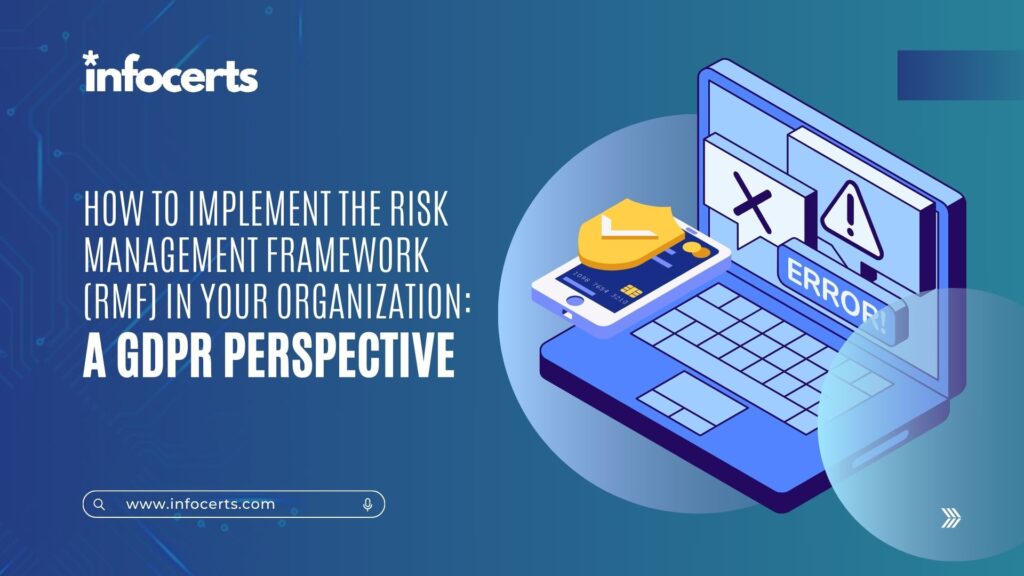Data security is a key concern under GDPR, and implementing a GDPR risk management framework is crucial for mitigating cybersecurity threats and data breaches.
1. Steps for Implementing RMF
Implementing RMF is a structured process that helps organizations manage their cybersecurity risks efficiently. Here are the core steps:
| Steps | Description |
|---|---|
| Step 1: Categorize Information | Identify the type of data (personal, sensitive, or confidential) to prioritize security controls. |
| Step 2: Select Security Controls | Choose the right security measures aligned with the GDPR and cybersecurity requirements. This includes encryption, access controls, and breach notifications. |
| Step 3: Implement Controls | Deploy the selected security measures throughout the organization’s systems and networks. |
| Step 4: Assess Effectiveness | Regularly evaluate whether the security controls are effectively protecting data and meeting data risk management standards. |
| Step 5: Authorize the System | Gain approval from senior management that the risk is managed according to GDPR compliance before putting systems into operation. |
| Step 6: Monitor Continuously | Continuously track and update security measures to address emerging threats and compliance gaps. |
Implementing RMF not only aligns with GDPR requirements, but also enhances overall data security across your organization.
2. Identifying Security Controls with RMF
Choosing the right security controls is fundamental in complying with GDPR and protecting personal data. Under RMF, the selection of controls focuses on:
- Data Encryption: Ensuring that sensitive data is encrypted both at rest and in transit.
- Access Control: Limiting access to personal data strictly to authorized personnel.
- Breach Notifications: Establishing systems for quick breach detection and mandatory reporting within the GDPR’s 72-hour notification window.
- Data Protection Officer (DPO): Appointing a DPO to oversee the organization’s compliance with GDPR and manage any related risks.
For more details on how to implement these controls effectively, consider exploring our GDPR course designed for IT professionals.
3. The Continuous Monitoring Process
Continuous monitoring is crucial for ensuring that the security controls remain effective and compliant with GDPR over time. This involves:
- Regular Audits: Conduct internal audits to verify ongoing GDPR compliance.
- Vulnerability Management: Regularly scan for vulnerabilities in your systems and address any weaknesses.
- Incident Response Plans: Have a comprehensive incident response plan that outlines steps to take when a data breach occurs.
Our company offers in-depth training on GDPR and continuous monitoring strategies. To enroll in our course and gain hands-on expertise, please contact INFOCERTS at +91 70455 40400.
4. Best Practices for RMF Compliance and Auditing
To ensure ongoing compliance with RMF and GDPR:
- Document Everything: Maintain detailed records of all data processing activities and security measures.
- Periodic Reviews: Update risk assessments and security measures regularly, especially after significant system changes or new threats.
- Training and Awareness: Regularly train staff on GDPR and cybersecurity compliance best practices to minimize human errors.
- Third-Party Vendor Audits: Ensure that all third-party vendors handling personal data are also compliant with GDPR and follow robust security practices.
By following these best practices, organizations can simplify the auditing process and ensure a high level of data protection, minimizing the risk of costly data breaches and regulatory penalties.
Conclusion
Integrating RMF into your organization’s data security strategy helps ensure compliance with GDPR and enhances overall cybersecurity. Regular monitoring, selecting the right controls, and following best practices for compliance and auditing will protect your organization from data breaches and other cybersecurity risks.
For IT professionals looking to enhance their knowledge of GDPR compliance, our GDPR course provides valuable insights. Enroll now by contacting infocerts at +91 70455 40400.
By implementing RMF with a focus on GDPR, organizations can manage data risks effectively and stay compliant in an ever-evolving cyber landscape.

